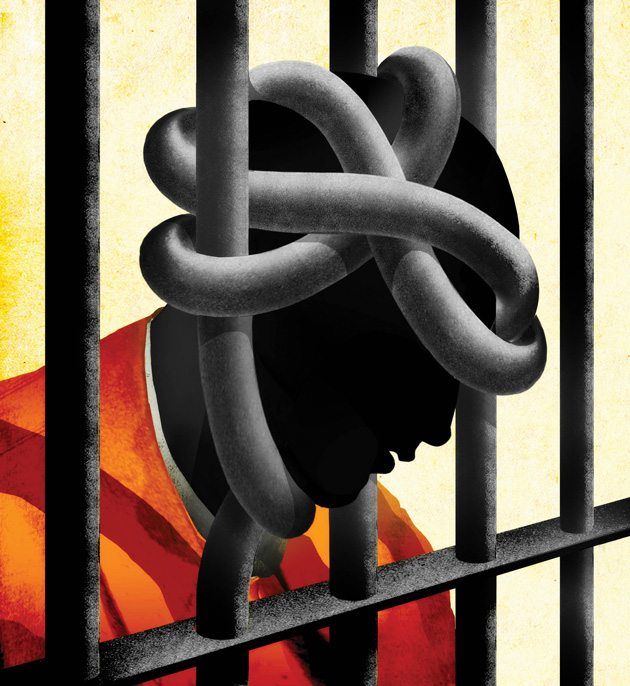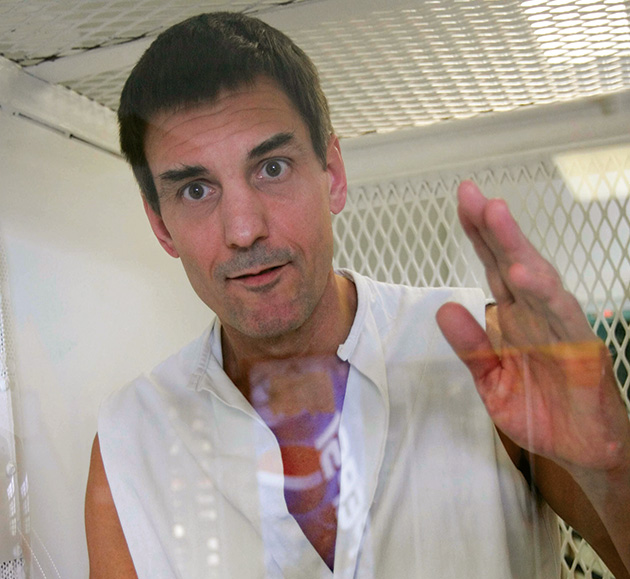
Six years before he shaved his head, donned camo fatigues, and fatally shot his in-laws in front of his estranged wife and daughter, Scott Panetti piled up furniture and valuables in his yard in Fredericksburg, Texas, and sprayed it all down with water to get rid of the devil he was sure had possessed the house.
It was hardly the first time he’d done something bizarre. Starting in his early 20s, Panetti had been diagnosed with paranoid schizophrenia, delusions, auditory hallucinations, and manic depression—he was hospitalized at least 14 times. Two years prior to the murders, he was involuntarily committed after swinging a cavalry sword at his wife and daughter. After he turned himself in for the 1992 killings, he blamed the crime on “Sarge,” one of several personalities he was convinced shared his body. The state charged him with capital murder.
The trial was a farce. Over even the prosecutor’s objections, Judge Stephen Ables let Panetti act as his own lawyer, and allowed him to continue representing himself after he went off his antipsychotic medication. The defendant showed up in court decked out in what a family friend described as a 1920s-era cowboy outfit: “He wore a large hat and a huge bandanna. He wore weird boots with stirrups—the pants were tucked in at the calf,” she later testified. “He looked like a clown.”
Standing before the jury, Panetti called himself “Sarge” and rambled incoherently for hours about everything from the TV show Quincy, M.E. to castrating a horse, with little interference from the judge—who did, however, intercede to question the relevance of belt buckles. In addition to his veterinarian, Panetti subpoenaed Jesus, John F. Kennedy, and the pope, and issued a stream-of-consciousness description of the crime:
Sarge is gone. No more Sarge. Sonja and Birdie. Birdie and Sonja. Joe, Amanda lying kitchen, here, there, blood. No, leave. Scott, remember exactly what Sarge did. Shot the lock. Walked in the kitchen. Sonja, where’s Birdie? Sonja here. Joe, bayonet, door, Amanda. Boom, boom, blood, blood.
Demons. Ha, ha, ha, ha, oh, Lord, oh, you.
It’s hard to blame the jury that sentenced Panetti to die. At the time, Texas had no option for life without parole, and some of the jurors stated they were scared he’d get out someday. But whether or not Texas executes a schizophrenic man isn’t simply about that man and his crimes. It’s about the moral ground on which America’s legal system rests.
That’s essentially what the United States Supreme Court ruled in the 1986 case of Ford v. Wainwright. Citing centuries of English common-law precedent, the court pronounced that a civilized society cannot condone the execution of a person with so weak a grasp on reality that killing him, as Justice Thurgood Marshall concluded for the majority, “has questionable retributive value, presents no example to others, and thus has no deterrence value, and simply offends humanity…Whether the aim is to protect the condemned from fear and pain without comfort of understanding, or to protect the dignity of society itself from the barbarity of exacting mindless vengeance,” the Constitution forbids it as cruel and unusual punishment.
How is it, then, that Scott Panetti has spent nearly two decades on death row, even though the justices have since reaffirmed the ban on executing the insane—in a ruling on his specific case? How is it that he came within eight hours of lethal injection this past December, only to be saved by a last-minute stay? And how is it that numerous seriously mentally ill people have been put to death in recent years, in defiance of the law of the land?
The short answer is that, despite its lofty rhetoric, the Supreme Court punted on how states should determine whether someone is sane enough to be killed. In fact, were it not for the persuasive powers of Marshall, who had handled capital cases as an NAACP lawyer, the court wouldn’t have even taken the Ford case—let alone cast five votes in the petitioner’s favor. But Marshall couldn’t convince the holdouts, including Justice William Rehnquist, who pointed out in his dissent that death row inmates were liable to simply fake mental illness. Giving them an opportunity for a preexecution sanity hearing, he wrote, “offers an invitation to those who have nothing to lose by accepting it to advance entirely spurious claims of insanity.”
In the end, the court offered little guidance on how to define insanity for legal purposes. Marshall had suggested that a prisoner too impaired to assist in his own defense could not be executed. But the legal test that most of the lower courts ultimately adopted was that of Justice Lewis Powell: The offender had to be “unaware of the punishment they’re about to suffer and why they are to suffer it.” That is “an extremely low standard,” explains Phillip Resnick, the director of forensic psychiatry at Case Western Reserve University’s medical school. “You can be quite psychotic and still know those two things.”
Further muddying the waters, the Supreme Court left the interpretation of its ruling to state court judges, who are often elected and who can share the public’s misconceptions about psychiatric illness—not understanding, for instance, that even highly delusional people can seem normal in certain settings. (Prosecutors in Panetti’s case recently exploited this misunderstanding by citing lucid snippets from a taped conversation with his visiting parents to argue that he is not insane, even though, in the same conversation, Panetti recalls grooming steers with former CIA agent Valerie Plame.)
“The law is still basing decisions on folk psychology,” notes Christopher Slobogin, a professor of law and psychiatry at Vanderbilt University. Some judges, he says, “worry that mental illness is this very wide-ranging concept that could apply to a huge percentage of the population depending on how it’s defined.”
The result of all of this ambiguity has been a steady stream of executions of profoundly mentally ill people, some of whom—like Nollie Lee Martin, a Florida man executed in 1992—were literally missing pieces of their brains. According to a study published in the Hastings Law Journal this past June, 18 of the 100 most recently executed convicts had been diagnosed with schizophrenia, PTSD, or bipolar disorder. Another 36 had other serious mental-health problems or chronic addictions that in some cases had rendered them psychotic.
Following his conviction, Panetti tried to waive his right to a lawyer for the appeal (a move akin to suicide), but Judge Ables ruled him too mentally incompetent to make that choice. After many more appeals, Ables set a 2004 execution date and ruled, without a hearing, that Panetti was sane enough to die. The case ultimately landed before the Supreme Court, where Texas Solicitor General Ted Cruz (now the state’s junior US senator) defended the state’s right to execute Panetti.
In 2007, the court ruled 5-4 that Judge Ables not only had unjustly denied Panetti a hearing on his mental state, but that the federal court reviewing the decision had applied an incompetency standard that was too restrictive. It wasn’t enough that Panetti knew the state was going to execute him for the murders of his in-laws, the court said. After all, it acknowledged, Panetti could regurgitate these facts. But he also sincerely believed that the state wanted to execute him to stop him from preaching the Gospel.
Writing for the majority, Justice Anthony Kennedy proclaimed, “A prisoner’s awareness of the State’s rationale for an execution is not the same as a rational understanding of it.” The 5th Circuit Court of Appeals had ignored the reality that “gross delusions stemming from a severe mental disorder may put that awareness in a context so far removed from reality that the punishment can serve no proper purpose.” The 5th Circuit was ordered to further investigate Panetti’s mental state based on this new “rational understanding” standard.
But the Supreme Court’s attempt to codify and expand upon the vague guidelines it set out in the Ford case has made little difference in practice. Judges often ignore the new guidelines, or rule in a way that simply reiterates Ford. Cornell law professor John Blume recently did some number crunching involving “Ford claims,” the last-ditch defense petitions arguing that a person is too insane to be executed. He found that the Panetti decision had little impact on the outcomes, especially in the states with the most active death chambers.
Florida, third in the nation in executions last year, has never found anybody too insane to execute. Nor have Alabama, Georgia, Tennessee, or Utah. In Texas, the most prolific killer of convicts, the last time a prisoner prevailed on such a claim was back in 2006, a year before the Panetti decision—which so far hasn’t even saved Panetti himself.
So how do judges decide whether a prisoner is too delusional for a civilized society to execute? Often, it turns out, they rely on psychiatrists whose recommendations seem to have little basis in science—hired guns whose testimony can give pro-death-penalty jurists cover for rulings that otherwise would seem to contradict the dictates of the Supreme Court.

Consider Dr. Alan Waldman, a forensic psychiatrist and neurologist whose testimony has helped send at least three mentally ill men to their demise, and whom Texas hired to evaluate Panetti in advance of a 2008 hearing on the prisoner’s fitness for execution. Waldman spent his early career working in various hospitals and clinics, including a stint with the Florida Department of Corrections. Today, he works in private practice and serves as an expert witness for both prosecutors and defense lawyers, holding himself out as an expert in the detection of malingering—feigning or exaggerating symptoms of illness—although he admitted during the Panetti hearing that he’d never published anything on the subject in a peer-reviewed journal. In fact, the only published work since 1993 listed in Waldman’s public resume is an article in a prosecutors’ newsletter.
When I reached out to Waldman, he directed his secretary to tell me that he would not talk to me under any circumstances and “don’t call back.” But he has a considerable public track record, having served on “competency commissions”—panels of psychiatrists convened to assess whether an inmate is too insane to execute—in three Florida death penalty cases. Like Panetti in Texas, each of these three prisoners had a long history of mental illness. But Waldman deemed all of them legally sane.
One of them was Thomas Provenzano, an Orlando man who signed documents “Jesus Christ” and showed pictures of Jesus to his nephews and nieces. “That’s me,” he’d whisper. “A five-year-old kid could tell my brother had mental problems,” his sister, Catherine Forbes, told me.
In the mid-1970s, Provenzano checked himself into a mental hospital because he was hearing voices. He was eventually released, but his behavior grew increasingly bizarre, to the point where his sister begged the doctors to have him committed. (They demurred.) In 1983, he was arrested for disorderly conduct after screaming obscenities at pedestrians and leading police on a car chase. Following the arrest, he started dressing like Rambo and hanging out at the courthouse, obsessing over his legal file and the officers who’d apprehended him. In early 1984, he smuggled three guns into an Orlando courthouse, where he shot and killed one man and critically injured two other people before an officer shot him in the back. In the ambulance en route to the hospital, he yelled, “I am the son of God! You can’t kill me.”
In 1999, then-Gov. Jeb Bush signed Provenzano’s death warrant and appointed a competency panel that included Waldman. After evaluating Provenzano, Waldman reported that he was malingering.
The prisoner’s sister was dumbstruck. She tearfully recounted to me how her brother had spent more than 15 years on death row sleeping under his cot with a box on his head because he was hearing voices. But the Florida Supreme Court sided with Waldman, and Provenzano was executed in June 2000.
About six months later, Waldman had his own run-in with the law. He allegedly cut in front of a teenage girl at a red light, and she believed he’d clipped the front of her purple Saturn. But rather than pull over, she said, he took off when the light changed. Incensed, she followed him home to try to get his insurance information. According to a police report, Waldman emerged from his front door carrying an AK-47. He pointed the gun through the car window. “He was so close I could feel him spitting at me,” she told me.
She drove away and called the cops, only to be told that Waldman had reported her first, saying he was scared for his life. After corroborating the gist of her account, they arrested Waldman instead. The young woman, who asked me not to use her name, decided not to press charges, but says she’s still traumatized by the episode.
In 2012, Florida Gov. Rick Scott appointed Waldman and two other psychiatrists to evaluate John Ferguson, a prisoner with a 40-year history of paranoid schizophrenia who had once received free legal help from John Roberts Jr., now chief justice of the Supreme Court. Ferguson had killed eight people after he was released from a mental institution over the warnings of state doctors, including one who said he was homicidal and “should not be released under any circumstances.” After a 90-minute interview, Waldman and his colleagues concluded that Ferguson was legally sane. He was executed the following year. His last words: “I am the Prince of God and I will rise again.”
When Waldman evaluated Scott Panetti in 2007, the prisoner insisted on calling him “Dr. Grigson” after the late James Grigson, a.k.a. “Dr. Death”—the discredited Texas psychiatrist who inspired the Errol Morris film The Thin Blue Line. Grigson was known for testifying in capital trials, where he would almost invariably argue that the defendant was an incurable sociopath who would certainly kill again if allowed to live.
Waldman noted in his report that Panetti had answered most of the questions about his crime with Bible quotes and made-up stories, and had claimed JFK had once cleaned his burns. He’d talked like a cowboy, and said the other inmates hated him for his faith. (Prison staffers told Waldman the inmates didn’t like Panetti because “he screams and yells and is constantly disturbing the unit by preaching the Gospel.”) Panetti also told Waldman that “Sergeant Iron Horse” was his in-laws’ real killer.
Nevertheless, Waldman claimed that Panetti demonstrated “organized” thoughts and displayed no evidence of serious mental illness. Furthermore, the prisoner’s repeated references to Grigson proved that he was malingering. Waldman was unaware, he later admitted, that Grigson had in fact testified at Panetti’s trial, and that Panetti had been obsessed with him ever since.
For his efforts, Waldman charged the state at least $23,000. (The federal courts allotted Panetti a total of $9,000 to hire his own experts.) When Panetti’s lead lawyer cross-examined Waldman in federal court before Judge Sam Sparks, she demonstrated that Waldman was unfamiliar with key details of the case and hadn’t given Panetti a single test or standard psychological exam, even though such tests—including one to assess whether a patient is faking schizophrenia—are used regularly in the field. When the attorney asked about the AK-47 incident, Sparks cut her off. He found Panetti eligible for execution.
Panetti’s lawyers appealed again. But the 5th Circuit Court of Appeals, which covers the busy death penalty states of Texas, Louisiana, and Mississippi, ruled that Panetti was sane enough to die, quoting Waldman at length—even though he was the only one of six experts to testify that Panetti wasn’t affected by any psychotic disorder. Last October, the Supreme Court declined to reconsider his case, and Texas moved to execute him on December 3. Only after a national uproar that drew in prominent conservatives—among them former Texas congressman Ron Paul, former Virginia Attorney General Ken Cuccinelli, and Maggie Gallagher, cofounder of the National Organization for Marriage—did the 5th Circuit hold up the execution.
So what might a competency process look like if it were conducted in the spirit of the law? This past November, Jane Woodward Miller, a state court judge in Indiana, gave the nation’s judiciary a glimpse.
The Indiana Supreme Court had appointed Miller to determine the mental competence of Michael Overstreet, a man convicted of abducting, raping, and murdering a college student. Overstreet had shown symptoms of psychosis at 17, had been in a mental hospital prior to the murder, and, once in prison, was repeatedly diagnosed with paranoid schizophrenia by state doctors. By 2013, he had intractable hallucinations of “shadow people” and firmly believed he was already dead and in a coma. He thought his execution would free him from purgatory and bring him back to be with his family—and this was when he was on his meds.
To assess whether Overstreet was sane enough to execute under the Panetti standard, Miller held a hearing lasting four days (twice as long as Panetti’s). It involved 13 witnesses and nearly 1,300 pages of medical records. The state, which acknowledged that Overstreet suffered from severe mental illness, could rally but a single mental-health expert, a doctor with limited experience in forensic psychology.
Although the case itself was similar to Panetti’s, the outcome was entirely different. The judge personally watched hours of video of the doctors interviewing Overstreet. She also scrutinized their credentials and grilled them on their understanding of the Supreme Court’s Panetti decision. Her 137-page opinion determined that the state’s mental-health expert’s report wasn’t especially thorough or his conclusions especially credible. And while Overstreet knew the state wanted to execute him and why (the test Powell had suggested in Ford), that wasn’t enough to justify his execution under the Panetti standard. “This Court concludes Overstreet means exactly what he said: He is dead, in a coma,” she wrote. “And that is a delusion…Delusions or other psychotic symptoms cannot simply be discounted because a petitioner has a cognitive awareness of his circumstances.”
One of the local prosecutors went ballistic, texting to the Indianapolis Star, “the idea that this convicted rapist murdering monster is too sick to be executed is nothing short of outrageous and is an injustice to the victim, her mother, the jury, and the hundreds of people who worked to convict this animal.”
But in December, state Attorney General Greg Zoeller announced that Miller had done such a good job of adhering to the Panetti ruling that there was nothing to appeal. Overstreet will remain in prison for life, and cannot be executed unless he one day recovers his sanity, which isn’t likely.
As for Panetti, he remains on death row, growing increasingly paranoid and delusional, according to court filings, as he waits for a panel of federal judges to decide whether the Supreme Court case bearing his name might, in fact, apply to him.













